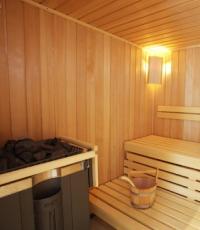Homemade generator from the engine from the washing machine. Electric generator - alteration of the engine from the washing machine
Electric motor from washing machine it is very easy to find in view of the fact that it rarely fails compared to other nodes, and the machines themselves are thrown into a landfill all the time. The thing for do-it-yourselfers is very valuable, I take into account how many simple machines can be built on its basis.
This motor can also work as a generator. But unfortunately, just like that, it will not generate energy, since there are no permanent magnets in it that can create an EMF in its windings.
How to start the engine from a washing machine as a 220 V generator
The engine from the washer has a classic structure of a collector electric motor. And it can work on both direct and alternating current. It's all about managing it.Typically, the motor from the washing machine has 6 pins on the connection block: the first pair on top are the pins of the tachometer sensor, we won't need them to control the speed. The second two in the middle are the stator winding leads. The third lowest pair are the rotor leads.

To make the motor generate current, you need to apply some voltage to the rotor. This will create a magnetic field on it, which in turn, when it rotates, will create an EMF on the stator winding.
We connect the wires to the rotor, to which the power source will be connected in the future.

We connect the wires to the stator. To the ends of the wires - a multimeter to measure the voltage at the output.

To show, we turn the motor shaft without a source connected to the rotor.

As a result, the multimeter showed zero volts and this is understandable.
We connect the power source. A 3.7 V lithium-ion battery will serve as it. Again, turn the shaft by hand.

The multimeter gave a certain value, which means that energy is being generated.
We change the 3.7 V battery to a 12 V battery. We rotate it by hand.

Result: tension rises.
To create a greater moment corresponding to the operating speed of the engine, we wind a winch on the pulley.

Drag, creating rotation.

Although the multimeter shows 75 V, in real life the voltage is higher, since the electronic device has a delay and is not able to count instantaneous bursts of electricity.
For clarity, we will connect an incandescent lamp to 220 V. We will also wind the winch and pull it.
The lamp will flash for a short time.
Conclusion
The motor from the washing machine is quite suitable as a voltage generator, but it is difficult to “attach” it somewhere, since it: gives out direct current, requires high speeds, requires additional power for operation, and if it stops, this power must be turned off somehow.But there are pluses: the output current can be easily controlled by adjusting the current of the rotor circuit, there is no magnetic sticking, small size compared to permanent magnet generators.
It is not easy to acquire such a generator, since the work requires patience and some turning work. For it, they use a conventional asynchronous electric motor, which is available for automatic washing machines. It has a power of 170 ... 180 W; a generator made on the basis of such an electric motor will have 1.5 kW of power.


In addition to the engine itself, stock up on: cold welding; 32 neodymium magnets of different (5, 10, 20 mm) diameters; glue; rectifier; sandpaper. You will need a lathe; scissors; different screwdrivers; pliers.
First, the rotor of the engine is remade in order to subsequently install magnets on it. Remove the cores and, placing in lathe, cut them to a depth of 2 mm. Also arrange grooves of 5 mm depth.
To plant the magnets, a coating is made, which is then wrapped around the core. Apply tin. The diameter of the resulting template, the holes in it must correspond to the core, which is necessary for its tight fit to the surface of the latter.


The magnets are placed with equal gaps between each pair. If this is not done, then in the future they will stick together and the power of the generator will be lost. Placement of magnets is carried out on a strip of tin, which is first glued to the core with superglue. Do it evenly, excluding any slopes of the elements.
After the template with glued magnets is placed on the rotor, fill epoxy resin, cold welding all the gaps that exist between the parts. Next, the rotor surfaces are cleaned with sandpaper until smooth.
At the stator, they find wires that lead to the working winding. They are searched for with a multimeter. They have the same resistance. The rest of the wires are not needed and can be cut.
To check the generator, the working winding is connected to a rectifier, which must be connected to the battery through the controller. The terminals of the multimeter are connected to the latter in voltmeter mode.

Then, using a drill, a screwdriver, spin the generator rotor up to 800 ... 1000 rpm. The multimeter should show output voltage 200 ... 300 V. If it is small, then when placing the magnets, most likely, an inaccuracy was made - they are laid out on a template with different intervals between pairs.
Having made a generator and installed it on a chainsaw, we got a small power plant. The electricity it gives out is enough to light two small rooms, give work to the TV, computer. Instead of a chainsaw to rotate the rotor, you can arrange a windmill.
Electricity is an expensive resource, and its environmental safety is in doubt, because. hydrocarbons are used to generate electricity. This depletes the subsoil and poisons the environment. It turns out that you can provide the house with wind energy. Agree, it would be nice to have a backup source of electricity, especially in areas where power outages are common.
The conversion plants are too expensive, but with some effort you can assemble them yourself. Let's try to figure out how to assemble a wind generator with your own hands from washing machine.
Next, we will tell you what materials and tools will be required for the job. In the article you will find diagrams of a wind generator device from a washing machine, expert advice on assembly and operation, as well as videos that clearly demonstrate the assembly of the device.
Wind turbines are rarely used as the main sources of electricity, but as an additional or alternative they are ideal.
This good decision for cottages, private houses located in areas where there are often problems with electricity.
Assembling a windmill from old household appliances and scrap metal is a real action to protect the planet. Garbage is just as urgent an environmental problem as environmental pollution by products of combustion of hydrocarbons.
A homemade wind generator from a screwdriver or a washing machine engine will literally cost a penny, but it will help save decent amounts on energy bills.
This is a good option for zealous hosts who do not want to overpay and are willing to make some efforts to reduce costs.

Often used to make windmills with their own hands. automotive alternators. They do not look as attractive as industrial production structures, but they are quite functional and cover part of the electricity needs.
A standard wind generator consists of several mechanical devices, the function of which is to convert wind kinetic energy into mechanical energy, and then into electrical energy. We recommend that you look at the article about and its principle of operation.
For the most part, modern models are equipped with three blades to increase efficiency and start working when the wind speed reaches at least 2-3 m / s.
Wind speed is a fundamentally important indicator on which the power of the installation directly depends.
The technical documentation for industrial wind turbines always indicates the nominal wind speed parameters at which the installation operates with maximum efficiency. Most often, this figure is 9-10 m / s.
What energy costs can the installation cover?
Installing a wind turbine is cost-effective if the wind speed reaches 4 m/s.
In this case, almost all needs can be met:
- A device with a power of 0.15-0.2 kW will allow you to switch room lighting to eco-energy. You can also connect a computer or TV.
- A wind turbine with a capacity of 1-5 kW is enough to ensure the operation of basic household appliances, including a refrigerator and a washing machine.
- For autonomous operation of all devices and systems, including heating, you need a 20 kW wind generator.
When designing and assembling a windmill from a washing machine engine, wind speed instability must be taken into account. Electricity can disappear at any second, so the equipment cannot be connected directly to the generator.
This article will consider the conversion of the engine from the washing machine into an electric generator. All stages of the alteration will be step by step painted and illustrated, so if you have a broken washing machine, do not rush to throw it away!
Clean energy derived from natural resources is one of the most popular topics today. Imagine that in your country house or country house there is a generator that feeds all the resources of your household with free electricity. It can be a wind turbine or a hydro turbine, it doesn't matter. Do you think these are all fairy tales? Not at all.
In fact, these are technical developments that are not so difficult and expensive to implement at home with your own hands.
One of these options based on a brushless DC motor, we want to present today. The author proposes to remount such an engine from a washing machine into a generator, soldering the leading stator coils in a special way. After such alteration, the engine can be used for a wind turbine. And if it is equipped with a water intake device like a Pelton turbine, then it is possible to build a hydroelectric generator.
Necessary materials and tools
As you probably already understood, today we only need the engine itself from the washing machine. The author used a DC inverter motor from the American Fisher & Paykel washing machine. Such engines are used in their products by LG, which is present in our domestic market.
We will also need:
- Soldering iron, flux and solder;
- Hot glue;
- Fine-grained sandpaper - zero.
Instruments:
- wire cutters
- Pliers
- painting knife
Starting to rebuild the engine
To work, it will be necessary to dismantle the engine from the machine body. It consists of three main parts:
- Stator - a round platform with driving winding coils located along the outer edge of the circle;
- The rotor is a plastic or metal cover with a plastic core. Permanent magnets are placed along the perimeter of its inner wall;
- Shaft - the central part of the engine, equipped with bearings to transfer kinetic energy to the drum of the washing machine.
We will work directly with the starter.

Stator preparation
We place the engine platform on the table, and get to work. Our goal is to solder the phase connections according to a different scheme than the original (photo).


For convenience, you can mark groups of 3 coils with a marker. We cut each of the 6 coil outputs with wire cutters according to the diagram.


The cut edges must be bent with a screwdriver or by hand, so that it will be more convenient to work with them later.


We clean each contact with fine-grained sandpaper to improve soldering.


When everything is ready and cleared of debris, we connect together every second group of three contacts. Strengthen hand twisting with pliers.


With a soldering iron, we tin the twist with the help of a flux, and solder it with tin solder. We open the twist, and solder it from the back. We do the same with the rest of the contacts. As a result, we should get seven twists.



Phase loop
We clean the contact group used to supply power to the engine.


Now you need to loop the remaining 3 phases. We select the ring for the first phase. We make it from a piece of copper multicore cable. We mark and cut it to the size of the inner circumference of the platform.


We expose the insulation at the junctions with free contacts, and clean them with sandpaper. We begin to solder the ring from the contact group, passing each of the seven, ending with the last contact. For a reliable connection, we tie the end of the contact on the ring.




We loop the second and third phases by analogy with the first. Care must be taken not to solder adjacent contacts to each other.






Application of insulation
Our conversion of the engine to the generator is ready. It remains only to isolate the spikes on the ring and coils. An alternative method was used by the inventor, using hot glue as an insulator.


According to him, such isolation has never failed. However, for those who are not sure about this method, it is worth using electrical tape. At the end of the work, the engine is assembled, and it can be used in the prefabricated structure of the generator set.
Electricity is a rather expensive source, whose environmental safety is in doubt. This is due to the fact that hydrocarbons are used to produce electricity. These processes not only consume subsoil, but also poison the environment. You can provide the room with wind energy. Such installations are not cheap, but you can make a wind generator from a washing machine engine with your own hands.
Such devices are rarely used as the main sources of electricity, but as additional ones they are quite optimal. This perfect option for giving, country houses, which are located in places where power outages often occur. Homemade design from the engine of a washing machine or a screwdriver will be very cheap and will help save significant amounts on energy costs.
This is a great solution for thrifty hosts who do not want to overpay and are willing to work hard to reduce costs. The classical design includes mechanical devices, the main purpose of which is the conversion of the kinetic energy of the wind into mechanical, and then into electrical. The bulk modern models equipped with three blades. This is necessary to increase the coefficient useful action. They begin to function at a wind speed of 2–3 m/s.
Wind speed is the most important indicator, because the performance of the unit depends on it. In the technical documents for industrial windmills, indicators are always indicated at which the product operates with maximum efficiency parameters. In most cases, this value is 9−10 m/s.
There are also maximum allowable wind speeds. They vary between 23−25 m/s. With such indicators, the efficiency of the wind generator is significantly reduced, because the blades of the unit change position. If we talk about a self-made installation, it is extremely difficult to calculate the technical characteristics in it.

It is necessary to focus on average values, and then calculate the right amount of electricity for basic needs.
Unit profitability
Installing a wind turbine is justified if the wind speed exceeds 4 m/s. In such a situation almost all needs can be met:
- A product with a capacity of 0.15-0.2 kW will be able to convert the lighting of the premises to environmentally friendly energy. In addition, it will be possible to connect a TV or PC.
- A design with a power of 1-5 kW will be able to ensure the functioning of appliances, including a washing machine and a refrigerator.
- For the operation of all systems and equipment on environmentally friendly energy, including heating, a unit with a capacity of 20 kW is required.

When making a wind generator from a washing machine with your own hands, you should take into account the instability of the wind speed.
Electricity can disappear at any moment, so household appliances must not be connected directly to the device. This requires batteries and a device to control the charge, since electrical equipment requires a voltage of 220 V.
To make the unit with your own hands, you will need to buy several parts. Many of them can probably be found in old household appliances, but some will need to be purchased. Essential elements:

If you purchase a ready-made station, along with the installation you need to pay 70-80 thousand rubles. A home-made wind generator will cost no more than 3.5-4 thousand rubles.
The difference in cost is significant, so it is advisable to make and install the structure on your own. The result is a unit with a power rating of about 2.5 kW. This is quite enough for the functioning of household appliances.
Principle of operation and types of products
All wind turbines are different, regardless of whether they are industrial or do-it-yourself. Their classification is carried out on several grounds:

With the independent production of a windmill, you first need to decide on the design. In addition, it is necessary to calculate the required power taking into account the operating conditions.
Horizontal structures are more preferable because their production does not require high-precision calculations. Such a windmill is much easier to make, it starts to work even with a small wind. The disadvantage is the bulkiness of the product and noise during operation.
 The vertical unit is suitable for those who have time to assemble and install a complex but compact system. The windmill operates by moving the blades that are attached to the rotor. The latter is fixed on the generator shaft, which generates a flow of electricity. Further, the energy is supplied to the battery devices, where it accumulates, and then supplies power to household appliances.
The vertical unit is suitable for those who have time to assemble and install a complex but compact system. The windmill operates by moving the blades that are attached to the rotor. The latter is fixed on the generator shaft, which generates a flow of electricity. Further, the energy is supplied to the battery devices, where it accumulates, and then supplies power to household appliances.
Advantages and disadvantages
Windmills have been popular for a very long time. Designs are constantly being improved, and the wind is an easily accessible energy source. Devices powered by it are environmentally safe and convenient, because they are placed on masts without occupying usable space. The units are easy to maintain and repair.
Structures emit sound during operation. The noise can be louder or quieter, but it is always present. Often this aspect interferes with the owners of the house and neighbors. There are other disadvantages as well.
Wind is an extremely unpredictable element. Because of this, the activity of the generator is unstable, so you need to accumulate energy so that in calm weather you will not be left without electricity.
Manufacturing instructions
For the production of a wind generator, you will need an engine from a washing machine with a capacity of 1.5 kW. Besides, you will need:
- neodymium magnets 0.5-1.2 cm in size - 32 pcs.;
- sandpaper;
- epoxy resin;
- glue.
 Magnets can be bought online or retail chains. They need to be installed on the rotor. From the latter, it is necessary to remove the cores or cut off part of them on a lathe. Then they make grooves with a depth of 5 mm.
Magnets can be bought online or retail chains. They need to be installed on the rotor. From the latter, it is necessary to remove the cores or cut off part of them on a lathe. Then they make grooves with a depth of 5 mm.
When the design is ready, it is necessary to install the magnets in the places provided. First of all, a tin coating is made for the core, and then the magnets are installed at the same distance from each other. It is important to observe the distance, otherwise the magnets will stick together during operation, and the performance of the device will be significantly reduced.
The finished magnetic template is placed on the rotor, and the gaps are filled with epoxy. When the procedure is over, clamp the rotor in a vise and carefully grind the surface with sandpaper. After that, the condition of the bolts on the bearing and housing should be checked. If the elements are worn out, it is recommended to replace them.
Health check
To check the operation of the assembled wind generator, you will need additional devices. Among them:
- rectifier;
- tester;
- battery;
- controller.
First of all, you need to determine which wires come from the working winding, and remove all the rest.
These conductors must be connected to the rectifier. The latter is connected to the controller, which is connected to the battery. The system is ready for testing.
 The power of the windmill is checked as follows: a voltmeter is brought to the battery, and the assembled unit is spun with a conventional drill or screwdriver. It should be noted that the speed of the latter must be at least 800 rpm, best option- 1000. Normal indicators are 200-300 V.
The power of the windmill is checked as follows: a voltmeter is brought to the battery, and the assembled unit is spun with a conventional drill or screwdriver. It should be noted that the speed of the latter must be at least 800 rpm, best option- 1000. Normal indicators are 200-300 V.
When assembling a wind turbine from a washing machine, it may be difficult to manufacture an impeller. You need to choose a lightweight, but at the same time durable material. A good solution is fiberglass blades. They are light in weight, but very reliable and durable. For the mast, steel pipes with a diameter of 32 mm are enough.
Installation process
The first step is to choose a suitable place for the wind generator. It is desirable to install the support in an open area, the top of the hill is best suited for this. Many experienced craftsmen believe that the higher the supporting structure, the better. Step by step:

To protect the wind turbine from various weather conditions, you can make a canopy over it. Such designs significantly increase the operational life of the product.
Experts do not advise immediately connecting expensive and powerful household appliances to the windmill. First you need to test the design on a phone charger or other simple devices.

A wind generator is the best option as an alternative source of energy, but it can also become the main one for small buildings or country houses. A homemade device will work for more than one year. In addition, a hand-made product will save a lot family budget. The main thing is to carefully study the information and not be afraid of experiments.





